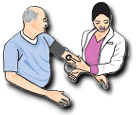|
"Malnutrition" refers to undernutrition or overnutrition,
either of which creates significant health risks in the elderly.
A recent review of nutritional studies in Topics in Clinical
Chiropractic covered the incidence and causes of malnourishment
in seniors, and brought up the dangers of not eating right.
The review noted that a quarter of all men and half of all
women over age 65 in America are considered overweight. Obesity
is associated with adult-onset diabetes, high blood pressure,
coronary artery disease and several forms of cancer (breast,
colon, uterine). Body shape may be more important than a simple
weight-height ratio when assessing overnutrition: fat concentrated
around or above the waistline (e.g., a potbelly) is more closely
associated with cardiovascular diseases, stroke, and diabetes
than fat centralized around the hips.
Undernutrition, either from being too thin or lacking certain
nutrients, occurs in 5-20% of seniors and is related to increased
risk of death, infection, osteoporosis and degenerative diseases.
Medical causes may be seen in 93% of undernutrition cases
(due to medications seniors are taking); other causes include
anorexia, cancer, depression and hypothyroidism. Protein and
 vitamin/mineral
deficiencies are common in undernourished individuals. Although
people require fewer calories as they age, they should not
reduce nutrient intake. vitamin/mineral
deficiencies are common in undernourished individuals. Although
people require fewer calories as they age, they should not
reduce nutrient intake.
Nutritional supplements containing vitamin C, B vitamins
and zinc may lessen the effects of undernutrition. A diet
packed with fruits, vegetables and adequate amounts of protein
can provide the best form of absorbable nutrients. If you
are overweight, try to shed some extra pounds by eating fewer
calories and staying physically active.
Reference:
Thomas DR, Morley JE. Nutritional considerations in older
people. Topics in Clinical Chiropractic 2002:9(2),
pp. 7-24.
To read more on senior health, check out https://www.chiroweb.com/find/archives/senior.
|



